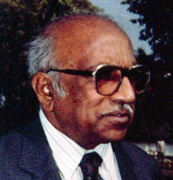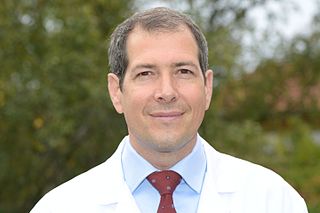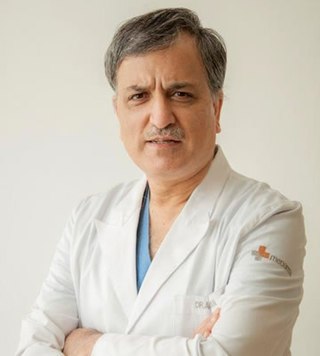
Interventional cardiology is a branch of cardiology that deals specifically with the catheter based treatment of structural heart diseases. Andreas Gruentzig is considered the father of interventional cardiology after the development of angioplasty by interventional radiologist Charles Dotter.

A thoracic aortic aneurysm is an aortic aneurysm that presents primarily in the thorax.
Aortic valve replacement is a cardiac surgery procedure whereby a failing aortic valve is replaced with an artificial heart valve. The aortic valve may need to be replaced because of aortic regurgitation, or if the valve is narrowed by stenosis.

Sir Magdi Habib Yacoub is an Egyptian-British retired professor of cardiothoracic surgery at Imperial College London, best known for his early work in repairing heart valves with surgeon Donald Ross, adapting the Ross procedure, where the diseased aortic valve is replaced with the person's own pulmonary valve, devising the arterial switch operation (ASO) in transposition of the great arteries, and establishing the heart transplantation centre at Harefield Hospital in 1980 with a heart transplant for Derrick Morris, who at the time of his death was Europe's longest-surviving heart transplant recipient. Yacoub subsequently performed the UK's first combined heart and lung transplant in 1983.
Daoud Anastas Hanania is a Jordanian heart surgeon. Hanania is a former Lieutenant General in the Jordanian Armed Forces and former Senator in the Jordanian Parliament.

Transcatheter aortic valve implantation (TAVI) is the implantation of the aortic valve of the heart through the blood vessels without actual removal of the native valve. The first TAVI was performed on 16 April 2002 by Alain Cribier, which became a new alternative in the management of high-risk patients with severe aortic stenosis. The implantated valve is delivered via one of several access methods: transfemoral, transapical, subclavian, direct aortic, and transcaval, among others.

Annuloaortic ectasia is characterized by pure aortic valve regurgitation and aneurysmal dilatation of the ascending aorta. Men are more likely than women to develop idiopathic annuloaortic ectasia, which usually manifests in the fourth or sixth decades of life. Additional factors that contribute to this condition include osteogenesis imperfecta, inflammatory aortic diseases, intrinsic valve disease, Loeys-Dietz syndrome, Marfan syndrome, and operated congenital heart disease.
David H. Adams is an American cardiac surgeon and the Marie-Josée and Henry R. Kravis Professor and Chairman of the Department of Cardiothoracic Surgery, Icahn School of Medicine at Mount Sinai Hospital in New York City. Dr. Adams is a recognized leader in the field of heart valve surgery and mitral valve reconstruction. As director of Mount Sinai Mitral Valve Repair Center, he has set national benchmarks with >99% degenerative mitral valve repair rates, while running one of the largest valve repair programs in the United States. Dr. Adams is the co-inventor of 2 mitral valve annuloplasty repair rings – the Carpentier-McCarthy-Adams IMR ETlogix Ring and the Carpentier-Edwards Physio II Annuloplasty Ring, and is a senior consultant with royalty agreements with Edwards Lifesciences. He is also the inventor of the Tri-Ad Adams Tricuspid Annuloplasty ring with a royalty agreement with Medtronic. He is a co-author with Professor Alain Carpentier of the benchmark textbook in mitral valve surgery Carpentier's Reconstructive Valve Surgery. He is also the National Co-Principal Investigator of the FDA pivotal trial of the Medtronic-CoreValve transcatheter aortic valve replacement device.
Cardiothoracic anesthesiology is a subspeciality of the medical practice of anesthesiology, devoted to the preoperative, intraoperative, and postoperative care of adult and pediatric patients undergoing cardiothoracic surgery and related invasive procedures.

Randall Bertram Griepp was an American cardiothoracic surgeon who collaborated with Norman Shumway in the development of the first successful heart transplant procedures in the U.S. He had an international reputation for contributions to the surgical treatment of aortic aneurysms and aortic dissection and in heart and lung transplantations. He received nearly $8 million in grants from the National Heart, Lung, and Blood Institute.

A hybrid cardiac surgical procedure in a narrow sense is defined as a procedure that combines a conventional, more invasive surgical part with an interventional part, using some sort of catheter-based procedure guided by fluoroscopy imaging in a hybrid operating room (OR) without interruption. The hybrid technique has a reduced risk of surgical complications and has shown decreased recovery time. It can be used to treat numerous heart diseases and conditions and with the increasing complexity of each case, the hybrid surgical technique is becoming more common.

Nagarur Gopinath was an Indian surgeon and one of the pioneers of cardiothoracic surgery in India. He is credited with the first successful performance of open heart surgery in India which he performed in 1962. He served as the honorary surgeon to two Presidents of India and was a recipient of the fourth highest Indian civilian award of Padma Shri in 1974 and Dr. B. C. Roy Award, the highest Indian medical award in 1978 from the Government of India.
Michael J. Reardon is an American cardiac surgeon and medical researcher. He is known for his work in heart autotransplantation for malignant heart tumors, an operation in which the surgeon removes the patient's heart, cuts out the malignant tumor, and reimplants the heart back in the patient's chest. He performed the first successful heart autotransplantation for a cancerous heart tumor in 1998.

Christoph Huber MD, FMH, FECTS is a Swiss cardiac surgeon who is a professor and the head of the Division of Cardiac and Vascular Surgery at the University Hospital Geneva, Switzerland.
Marjan Jahangiri FRCS, FRCS (CTh) is Professor of Cardiac Surgery at St. George's Hospital, University of London. She was the first woman to be appointed professor of cardiac surgery in the United Kingdom and Europe.

Dr. Anil Bhan is the Chairman of Cardiac Surgery Heart Institute, Medanta Hospital, Gurugram, India. He graduated from Medical College Srinagar. He has the largest experience in aortic surgery in India since he has designed and developed more than 50 surgical instruments in the field of cardiac surgery. He was one of the team members to perform the first successful heart transplant in India in1994. He served as a co-founder of Max Heart and Vascular Institute, Saket, New Delhi, Director and Chief Co-Ordinator, Cardio thoracic and Vascular Surgery, MHVI, Saket.Additional Professor, Cardiothoracic Surgery and Vascular Surgery, AIIMS, New Delhi.

Hazim J. Safi, MD, FACS, is a physician and surgeon who is well known for his research in the surgical treatment of aortic disease. Safi and his colleagues at Baylor College of Medicine were the first to identify variables associated with early death and postoperative complications in patients undergoing thoracoabdominal aortic operations. Safi now serves as professor of cardiothoracic surgery, and founding chair at McGovern Medical School at The University of Texas Health Science Center in Houston, TX.
John D. Puskas is an American researcher, author, inventor and cardiovascular surgeon. As of 2022, he is Professor, Cardiovascular Surgery, Icahn School of Medicine at Mount Sinai, and chairman, Department of Cardiovascular Surgery at Mount Sinai Morningside, Mount Sinai Beth Israel and Mount Sinai West. He holds 11 U.S. patents and co-founded the International Coronary Congress and the International Society for Coronary Artery Surgery. He is credited by ResearchGate with 330 publications and 15,234 citations and as of 2022 Scopus reports an h-index of 62. Puskas is known for advancing coronary artery bypass (CABG) surgery by refining surgical techniques for all-arterial, off-pump CABG and inventing finer instruments to be used for advanced coronary bypass surgical procedures. He is credited with performing the first totally thoracoscopic bilateral pulmonary vein isolation procedure. He is the co-editor of State of the Art Surgical Coronary Revascularization, the first textbook solely devoted to coronary artery surgery.
Mario F.L. Gaudino, MD, PhD, MSCE, FEBCTS, FACC, FAHA is an Italian cardiothoracic surgeon who is the Stephen and Suzanne Weiss Professor in Cardiothoracic Surgery (II) and Professor of Clinical Epidemiology and Health Services Research at Weill Cornell Medicine and an attending cardiac surgeon at NewYork-Presbyterian Hospital and Weill Cornell Medical Center. He is an expert in coronary revascularization and clinical trialist. He is known for conducting the PALACS trial, which demonstrated that posterior pericardiotomy at the time of cardiac surgery reduced the incidence of post-operative atrial fibrillation and pericardial effusion.
Joseph E. Bavaria, M.D., FACS, FRCS (Edin) ad hom, is an American cardiothoracic surgeon a professor of surgery at the University of Pennsylvania and Director of its Thoracic Aortic Surgery Program. Bavaria is known as a leading figure in clinical trials for catheter-based aortic valve replacement (TAVR), thoracic aortic surgery, and aortic endograft procedures (TEVAR). He wrote more than 600 research papers and founded the Penn Aortic Center. Bavaria served as the 52nd president of the Society of Thoracic Surgeons (STS) from 2016 to 2017, the 3rd President of the Thoracic Surgery Foundation (TSF) (2019-2022), the Chairman of The Society of Thoracic Surgeons/ACC TVT Registry Steering Committee (2017-2020) and an International Councilor of the European Association for Cardio-Thoracic Surgery (EACTS) (2021-2024) Bavaria has performed more than 9,000 surgeries throughout his career as of 2019.










